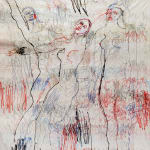Alice Kettle British, b. 1961
Schiffli series, Nepenthe, 2006
Thread on canvas
240 x 190 cm
Copyright The Artist
Further images
Schiffli Series As well as completing Looking Forwards to the Past in 2007, Alice Kettle also created a series of three huge works utilising the multi- needle schiffli embroidery machine...
Schiffli Series
As well as completing Looking Forwards to the Past in 2007, Alice Kettle also created a series of three huge works utilising the multi- needle schiffli embroidery machine at Manchester School of Art for the touring exhibition Mechanical Drawing – The Schiffli Project. The aim of this project was to show how a machine created for the commercial mass-production of embroidery for fashion and interiors could also be exploited to create one-off artworks.
A key feature of the schiffli machine is the mechanistic repeat, produced by having 86 needles stitching simultaneously. Alice subverted this uniformity by repeatedly changing thread colours and thicknesses, to create swathes of scribbled background colour that she then overlaid with monumental figures, dancing between the lines stitched by the schiffli machine.
These three works marked a significant turning point for Alice’s working methodology, she realised: ‘I do not have to cover the fabric with stitch; I can let each mark breathe. For the first time in 21 years I have liberated the fabric. Does that mean I am liberated too?’
Melanie Miller
Curator of Mechanical Drawing The Schiffli Project
As well as completing Looking Forwards to the Past in 2007, Alice Kettle also created a series of three huge works utilising the multi- needle schiffli embroidery machine at Manchester School of Art for the touring exhibition Mechanical Drawing – The Schiffli Project. The aim of this project was to show how a machine created for the commercial mass-production of embroidery for fashion and interiors could also be exploited to create one-off artworks.
A key feature of the schiffli machine is the mechanistic repeat, produced by having 86 needles stitching simultaneously. Alice subverted this uniformity by repeatedly changing thread colours and thicknesses, to create swathes of scribbled background colour that she then overlaid with monumental figures, dancing between the lines stitched by the schiffli machine.
These three works marked a significant turning point for Alice’s working methodology, she realised: ‘I do not have to cover the fabric with stitch; I can let each mark breathe. For the first time in 21 years I have liberated the fabric. Does that mean I am liberated too?’
Melanie Miller
Curator of Mechanical Drawing The Schiffli Project





